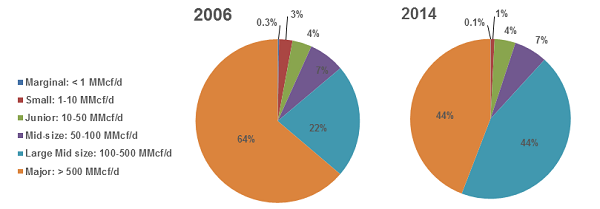Market Snapshot: Large Mid-size Companies Rival Major Producers in Share of Tight Gas Production from Western Canada
Release date: 2015-10-08
Large mid-sized producers have led a decade-long shift away from conventional resources toward tight gas production in western Canada. Tight gas production increased from 27 per cent of western Canadian natural gas production in 2006 to 42 per cent in 2014. In that same period, the share of “operated”Footnote 1 tight gas produced by majors decreased while large mid-sized producers’ share increased, such that both groups produced 44 per cent each in 2014.
Share of Western Canadian Tight Gas Production by Producer Size
Figure Sources and Description
Sources: Divestco, NEB calculations
Description: The above chart depicts the tight gas market share of production from western Canadian producers in 2006 and 2014, organized by total operated production. Large mid-sized producers gained the most market share, from 22 per cent in 2006 to 44 per cent in 2014. Declines in market share were experienced by major producers, from 64 per cent to 44 per cent, and small producers, from three per cent to one per cent. The share of tight gas production from junior and mid-sized producers remain essentially unchanged, while marginal and small producers maintain virtually no tight gas market presence.
Tight gas drilling techniques are very capital intensive, requiring large amounts of land and drilling capacity. Majors possess the scale and scope to produce tight gas resources, but they operate internationally and must allocate capital between various international projects. Following the 2006 peak in production, several majors focused on projects outside of Canada or sold their Canadian gas assets.
Like the majors, large mid-sized producers also possess the size, scale and land to attract investment capital and access debt markets. Further, the large mid-sized producers generally have more local or regionally focused asset bases and expertise. This has enabled them to lead all producer groups in Canadian tight gas production growth since 2006.
Marginal and small producers generally have insufficient drilling prospects to attract the investment capital needed for tight gas operations. Junior and mid-sized producers, who possess larger but still relatively small land bases, attract some investment capital, and have been able to maintain relatively stable shares of tight gas production at four per cent and seven per cent respectively.
- Date modified:

